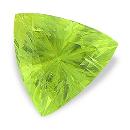|
|
|
|
Click on a letter above to view the list of gems. |
|
|
|
|
|
Titanite
(Sphene) |
|
| Chemistry: CaTiSiO5 [Calcium Titanium Silicate] | |
| Discovered
in 1795;
IMA
status: Valid (pre-IMA; Grandfathered). | ||
|
| ||
|
Classification |
|
|
| |
|
Silicates | |
|
8/B.12-10 | |
|
|
9 : SILICATES (Germanates) |
|
Related to: |
Titanite Group. Titanite - Malayaite Series. The titanium analogue of Malayaite. Isostructural with Durangite and Tilasite. |
|
|
|
|
Crystal Data |
|
|
|
|
|
Crystals wedge-shaped, flattened or prismatic by extension along [110], to 16 cm; compact, massive. |
|
|
On [100], contact and penetration; less commonly lamellar on [221]. |
|
|
|
|
|
Physical Properties |
|
|
|
|
|
[110] Distinct, [100] Imperfect, [112] Imperfect; parting due to twinning on [221] |
|
|
Sub-Conchoidal |
|
|
Brittle |
|
|
5.0 - 5.5 |
|
|
3.48 - 3.60 (g/cm3) |
|
|
None |
|
|
Mild; GRapi = 3,805.77 (Gamma Ray American Petroleum Institute Units) |
|
|
Other: |
May be metamict. |
|
|
|
|
Optical Properties |
|
|
|
|
|
Colorless, Reddish Brown, Red, Yellow, Green, Gray, Black |
|
|
Transparent to Translucent to Opaque |
|
|
Adamantine to Resinous |
|
|
1.843 - 2.110 Biaxial ( + ) |
|
|
0.1030 - 0.1600 (high) |
|
|
Extreme; r > v |
|
|
Visible; Distinct when deeply colored; X = nearly colorless; Y = yellow to green; Z = red to yellow-orange. |
|
|
|
|
|
Occurances |
|
|
|
|
|
Geological Setting: |
A common accessory mineral in intermediate and felsic plutonic rocks, pegmatites, and alpine veins. In gneisses, schists, and some skarns; rarely detrital. |
|
Common Associations: |
Albite, Allanite, Apatite, Biotite, Calcite, Chlorite, Diopside, Epidote, Ilmenite, Magnetite, Monazite, Nepheline |
|
Common Impurities: |
Fe, Y, Mn, Al, Ce, Sr, Na, Nb, Ta, Al, Mg, V, F, Zr, Sn |
|
Type Locality: |
Passau, Bavaria, Germany |
|
Year Discovered: |
1795 |
|
View mineral photos: | |
|
|
|
|
More Information |
|
|
|
|
|
| |
|
|
|
|
Notable
occurances of gemmy crystals include Gilget and Badakhshan Provinces, Afghanistan;
Pi~no Solo. From Campo do Boa, Capelinha, Minas Gerais,
Brazil; Antsiranana and Tuléar Provinces, Madagascar;
Skardu District, Baltistan, Northern Areas, Pakistan;
and Subpolar Ural Mountains, Russia. |
|
|
We
have not photographed our Titanite (Sphene) gems yet. Please
check back soon! |
